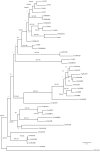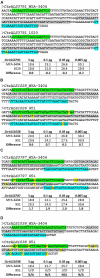Pursuing Advances in DNA Sequencing Technology to Solve a Complex Genomic Jigsaw Puzzle: The Agglutinin-Like Sequence (ALS) Genes of Candida tropicalis
- PMID: 33552012
- PMCID: PMC7856822
- DOI: 10.3389/fmicb.2020.594531
Pursuing Advances in DNA Sequencing Technology to Solve a Complex Genomic Jigsaw Puzzle: The Agglutinin-Like Sequence (ALS) Genes of Candida tropicalis
Abstract
The agglutinin-like sequence (ALS) gene family encodes cell-surface adhesins that interact with host and abiotic surfaces, promoting colonization by opportunistic fungal pathogens such as Candida tropicalis. Studies of Als protein contribution to C. tropicalis adhesion would benefit from an accurate catalog of ALS gene sequences as well as insight into relative gene expression levels. Even in the genomics era, this information has been elusive: genome assemblies are often broken within ALS genes because of their extensive regions of highly conserved, repeated DNA sequences and because there are many similar ALS genes at different chromosomal locations. Here, we describe the benefit of long-read DNA sequencing technology to facilitate characterization of C. tropicalis ALS loci. Thirteen ALS loci in C. tropicalis strain MYA-3404 were deduced from a genome assembly constructed from Illumina MiSeq and Oxford Nanopore MinION data. Although the MinION data were valuable, PCR amplification and Sanger sequencing of ALS loci were still required to complete and verify the gene sequences. Each predicted Als protein featured an N-terminal binding domain, a central domain of tandemly repeated sequences, and a C-terminal domain rich in Ser and Thr. The presence of a secretory signal peptide and consensus sequence for addition of a glycosylphosphatidylinositol (GPI) anchor was consistent with predicted protein localization to the cell surface. TaqMan assays were designed to recognize each ALS gene, as well as both alleles at the divergent CtrALS3882 locus. C. tropicalis cells grown in five different in vitro conditions showed differential expression of various ALS genes. To place the C. tropicalis data into a larger context, TaqMan assays were also designed and validated for analysis of ALS gene expression in Candida albicans and Candida dubliniensis. These comparisons identified the subset of highly expressed C. tropicalis ALS genes that were predicted to encode proteins with the most abundant cell-surface presence, prioritizing them for subsequent functional analysis. Data presented here provide a solid foundation for future experimentation to deduce ALS family contributions to C. tropicalis adhesion and pathogenesis.
Keywords: ALS genes; Candida tropicalis; fungal adhesion; gene expression; genome.
Copyright © 2021 Oh, Isenhower, Rodriguez-Bobadilla, Smith, Jones, Hubka, Fields, Hernandez and Hoyer.
Conflict of interest statement
The authors declare that the research was conducted in the absence of any commercial or financial relationships that could be construed as a potential conflict of interest.
Figures









References
-
- Coleman D. A., Oh S.-H., Manfra-Maretta S. L., Hoyer L. L. (2012). A monoclonal antibody specific for Candida albicans Als4 demonstrates overlapping localization of Als family proteins on the fungal cell surface and highlights differences between Als localization in vitro and in vivo. FEMS Immunol. Med. Micobiol. 64 321–333. 10.1111/j.1574-695X.2011.00914.x - DOI - PMC - PubMed
Grants and funding
LinkOut - more resources
Full Text Sources
Other Literature Sources
Miscellaneous

